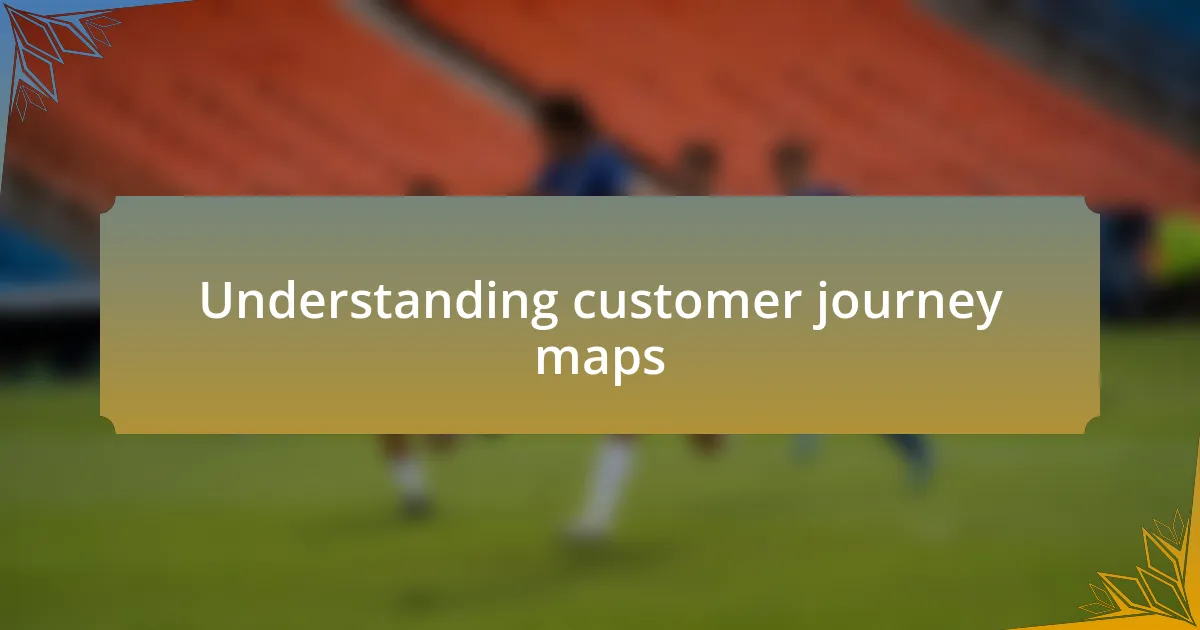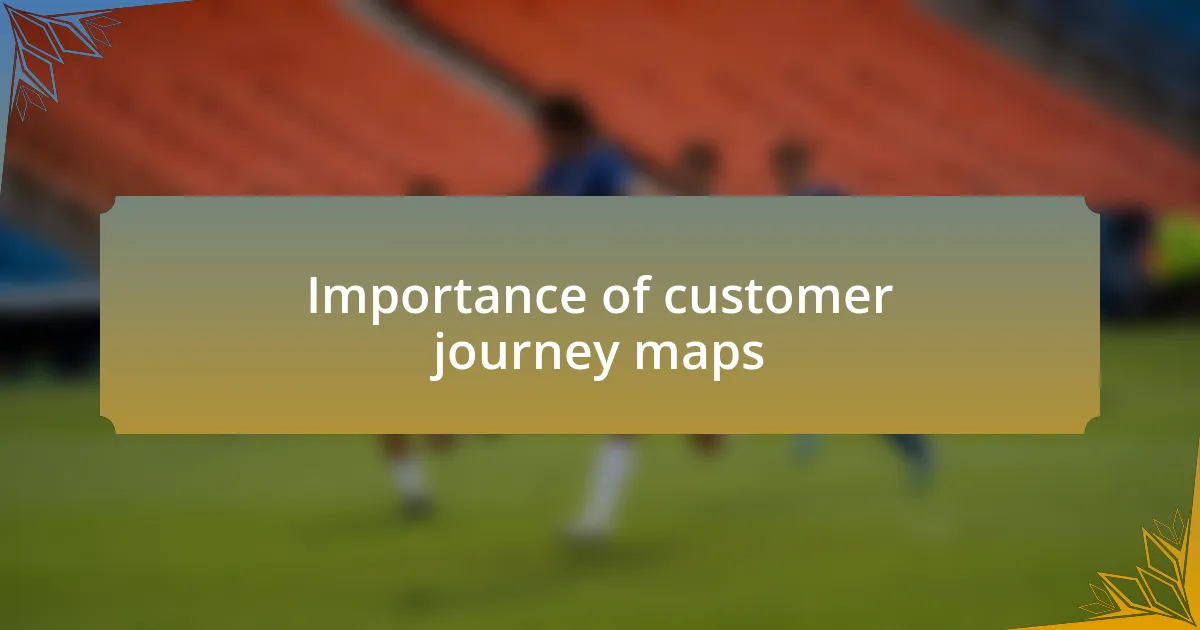Key takeaways:
- Customer journey maps visually represent the stages of customer interactions, helping identify crucial touchpoints and sentiments that impact overall experience.
- Collaborative efforts and diverse perspectives are essential in creating effective journey maps, as they provide valuable insights into customer needs.
- Emotional insights significantly enhance journey mapping; understanding customer feelings can drive necessary improvements and foster stronger connections.
- Revamping journey maps leads to better customer experiences, reinforcing the importance of ongoing feedback and adaptations to meet evolving expectations.

Understanding customer journey maps
Customer journey maps are visual representations that showcase the stages a customer goes through when interacting with a brand. From my experience, these maps help to identify touchpoints—those crucial moments where customers engage with your product or service. Have you ever noticed how a simple change in communication can enhance the overall experience? That’s the kind of insight a solid journey map can provide.
I remember a project where we revamped our customer journey map after analyzing feedback. Initially, the map depicted a linear flow, but we quickly realized customers often zigzagged through different channels. It was eye-opening to observe how their emotional states shifted at each touchpoint. For instance, a frustrated call to customer support could overshadow a positive in-store experience, illustrating just how interconnected every step is.
Understanding these maps isn’t just about tracking interactions; it’s also about gauging sentiments. I often ask myself, “What does the customer feel at each stage?” This question drives a deeper understanding of their journey and informs strategies for improvement. By empathizing with their experience, we can create a better path for them—one that turns frustration into satisfaction.

Importance of customer journey maps
Customer journey maps are crucial tools that align a company’s operations with customer expectations. Reflecting on my own work, I often found that these maps revealed gaps in our service delivery. Have you ever sat down with a team and dissected your customer’s path? It’s enlightening to see where you thought you were excelling, only to discover there’s room for significant improvement.
In one instance, I observed how a detailed customer journey map guided our team in realizing we were missing essential touchpoints, like post-purchase follow-ups. This oversight was affecting customer loyalty, and it struck me how simple it was to bridge that gap. It’s fascinating how small changes—like sending a personalized thank-you email—can make customers feel valued and understood.
Moreover, what I truly appreciate about customer journey maps is their ability to reveal not just the “what” but also the “why.” Reflecting on these insights often led me to ask, “Why do customers abandon their carts at a certain point?” Understanding the rationale behind these actions allowed us to adapt our strategies effectively. Isn’t it amazing how much clarity a well-crafted map can provide?

Key components of effective mapping
Key components of effective mapping
When creating customer journey maps, one of the essential components is identifying key touchpoints. In my experience, these moments are where customers interact with our brand, whether through an advertisement, customer service, or the product itself. Have you ever pinpointed a touchpoint that surprised you? I remember examining our social media interactions, only to realize they were a goldmine for customer sentiment insights.
Another crucial element is understanding customer emotions at each stage of the journey. I found that mapping out the feelings experienced by customers allowed us to tailor our approach. For instance, discovering that frustration peaked during the checkout process led us to streamline the experience. It was eye-opening to see how empathy could guide improvements that ultimately uplifted the entire customer experience.
Lastly, collaboration is vital in developing an effective journey map. Engaging cross-functional teams brought a wealth of perspectives that shaped our mapping process. The synergy between marketing, sales, and customer support was surprisingly insightful. I have often seen teams come together with differing views that spark innovation. Isn’t it something how diverse insights can lead to a more comprehensive understanding of our customers’ journeys?

Challenges in revamping journey maps
One significant challenge in revamping journey maps is the sheer complexity of integrating data from multiple sources. When I worked on a mapping project, I struggled to consolidate insights from customer feedback, behavioral analytics, and social media interactions into a coherent overview. Have you ever felt overwhelmed by conflicting data points? It can be frustrating, but finding a balanced approach is essential for creating an accurate representation of the customer experience.
Another hurdle I encountered was managing internal resistance to change. I vividly recall presenting a revised journey map that highlighted areas needing improvement. The pushback from team members who were attached to the old processes was unexpected. It made me realize how vital it is to communicate the benefits of the new map clearly; stakeholders need to see the value in evolving our customer journey.
Moreover, I often found that keeping the customer’s voice at the forefront was more challenging than anticipated. During a recent mapping session, I delved deep into customer stories, but I noticed that technology and internal metrics sometimes overshadowed their genuine feedback. How do we ensure that every customer’s unique perspective informs our journey maps? I believe it involves actively listening and incorporating real stories, allowing us to empathize with and better serve our audience.

My approach to revamping maps
Revamping journey maps requires a thoughtful and systematic approach that responds to both data and emotions. In my experience, I start by reviewing existing maps with a fresh set of eyes. I like to gather my team for brainstorming sessions and ask questions like, “What emotions do our customers feel at each touchpoint?” This encourages an open dialogue about the real experiences behind the data, allowing us to challenge assumptions and spark new ideas.
I also emphasize the importance of collaborating with cross-functional teams. During one project, I reached out to customer service representatives who interacted directly with clients. Their insights were invaluable—they highlighted common pain points that were missing in our previous maps. It was a reminder to me that sometimes the best information comes from those on the front lines, and involving diverse perspectives can lead to a more comprehensive view of the customer journey.
Finally, I prioritize iteration in my mapping process. After implementing a new journey map, I encourage ongoing feedback and adjust based on customer insights. I often reflect on a time when our revised map led us to identify a previously overlooked opportunity, ultimately improving customer satisfaction. Isn’t it fascinating how continuous refinement can lead to more meaningful connections with our customers? Keeping this iterative mindset helps ensure our maps stay relevant and truly reflect the evolving journey of our audience.

Lessons learned from my experience
One key lesson I learned is that emotions play a crucial role in shaping customer experiences. During one session, a team member shared a story about a customer who felt frustrated after a service failure. Hearing that personal connection opened my eyes to the importance of including emotional data in our journey maps. How often do we truly appreciate the feelings behind interactions? This story reminded me that empathy is not just a buzzword—it’s a powerful tool in understanding customer needs.
Another significant insight was the value of engaging directly with customers. I can still recall a time when I participated in a focus group and sat down with clients to hear their stories firsthand. Their candid feedback was eye-opening and challenged my assumptions. It was a reminder that we can’t just rely on data; real voices bring depth to our understanding, making the journey maps more relatable and effective. Isn’t it intriguing how a simple conversation can lead to profound revelations?
Lastly, I discovered the impact of flexibility in my mapping approach. There was a moment when I hesitated to change a key element of our journey map, fearing it might create confusion. But, when I finally took the leap, the outcomes were remarkable. Customers engaged more meaningfully with our brand afterward. This experience taught me that being open to change, even when it’s uncomfortable, is essential for making a real impact. How often do we cling to the status quo, even when our instincts suggest otherwise? Embracing change can lead to unexpected and rewarding results.

Impact on overall customer experience
Revamping customer journey maps can dramatically enhance the overall customer experience. I remember a project where we streamlined touchpoints after analyzing feedback. The reaction was almost instantaneous; customers reported feeling more understood and valued. That shift in their perception made me realize how critical each interaction is to the larger experience. Have you ever wondered how small changes can lead to significant customer loyalty?
Additionally, integrating emotional insights into our journey maps transformed our approach. For instance, I recall adjusting a communication strategy based on feedback indicating that customers felt overwhelmed during a specific phase. By addressing this emotional pain point, we not only simplified the process but also fostered a deeper connection. Isn’t it fascinating how emotional clarity can refine not just mapping but also the overall experience?
Overall, the impact of revamping journey maps extends beyond mere touchpoints; it cultivates a culture of care and responsiveness. I observed this firsthand when our changes led to a spike in customer engagement metrics. Those numbers reflected more than just data; they revealed a renewed trust in our brand. When have you seen numbers tell a story that resonates on a personal level? This journey showed me that thoughtful enhancements significantly shape how customers perceive and interact with our brand.